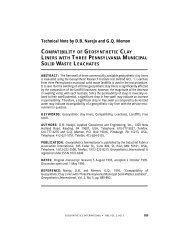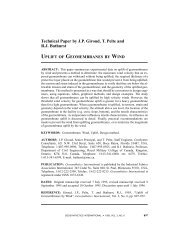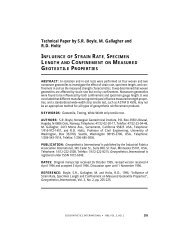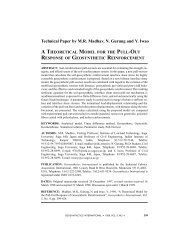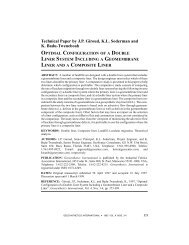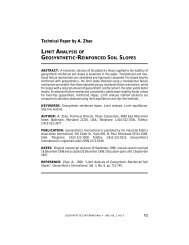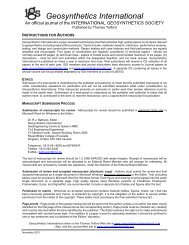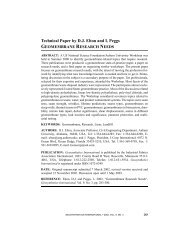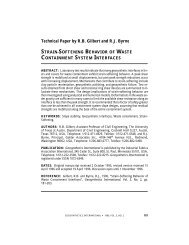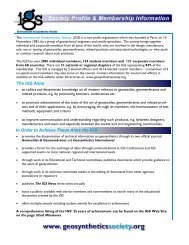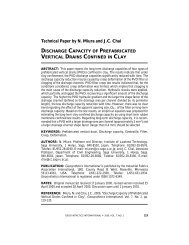leachate flow in leakage collection layers due to defects in ...
leachate flow in leakage collection layers due to defects in ...
leachate flow in leakage collection layers due to defects in ...
You also want an ePaper? Increase the reach of your titles
YUMPU automatically turns print PDFs into web optimized ePapers that Google loves.
GIROUD et al. D Leachate Flow <strong>in</strong> Leakage Collection Layers Due <strong>to</strong> Geomembrane Defects<br />
4.4.3 Wetted Fraction <strong>in</strong> the Worst Scenario<br />
In the worst scenario (Figure 9a), the <strong>leachate</strong> <strong>flow</strong> through each defect generates a<br />
wetted zone whose surface area is A wmax (Figure 7) given by Equation 62 (which is<br />
equivalent <strong>to</strong> Equation 97 or 80 depend<strong>in</strong>g on whether the <strong>leakage</strong> <strong>collection</strong> layer is<br />
full or not, respectively). Therefore, the surface area of the <strong>to</strong>tal wetted zone for the scenario<br />
where all the <strong>defects</strong> are at the high end of the <strong>leakage</strong> <strong>collection</strong> layer slope is<br />
expressed as follows, if all of the leaks are assumed <strong>to</strong> be equal, which is generally the<br />
case <strong>in</strong> design:<br />
n=<br />
N<br />
∑ Aw<br />
=<br />
n = 1<br />
N A<br />
wmax<br />
(101)<br />
Comb<strong>in</strong><strong>in</strong>g Equations 99 and 101 with R w = R w worst gives:<br />
R<br />
w worst<br />
NA<br />
=<br />
A<br />
wmax<br />
LCL<br />
(102)<br />
Comb<strong>in</strong><strong>in</strong>g Equations 100 and 102 gives:<br />
R<br />
w worst<br />
= FA<br />
w max<br />
(103)<br />
Comb<strong>in</strong><strong>in</strong>g Equations 62 and 103 gives the follow<strong>in</strong>g equation for the wetted fraction<br />
<strong>in</strong> the worst scenario:<br />
R<br />
wworst<br />
2F <strong>to</strong><br />
2 L s<strong>in</strong>b<br />
1<br />
3 s<strong>in</strong>b<br />
t<br />
=<br />
F H G<br />
I LF<br />
+<br />
KJ NM<br />
HG<br />
o<br />
/<br />
I<br />
-<br />
KJ<br />
2 3 2<br />
O<br />
QP<br />
1<br />
(104)<br />
Comb<strong>in</strong><strong>in</strong>g Equations 80 and 103 gives the follow<strong>in</strong>g equation for the worst scenario<br />
when the <strong>leakage</strong> <strong>collection</strong> layer is not full (t o < t LCL ), i.e. when the condition expressed<br />
by Equation 11 (or Equation 12, which is equivalent) is met:<br />
2 FQ<br />
32 /<br />
R L<br />
wworst= 1+ 2L k Q -1O<br />
2 d s<strong>in</strong> b / i<br />
(105)<br />
3k<br />
s<strong>in</strong> b<br />
NM<br />
Comb<strong>in</strong><strong>in</strong>g Equations 97 and 103 gives the follow<strong>in</strong>g equation for the worst scenario<br />
when the <strong>leakage</strong> <strong>collection</strong> layer is full <strong>in</strong> a certa<strong>in</strong> area around the primary l<strong>in</strong>er defect<br />
(t o > t LCL ), i.e. when the condition expressed by Equation 11 (or Equation 12, which is<br />
equivalent) is not met:<br />
R<br />
wworst<br />
L<br />
F<br />
IO<br />
R<br />
L<br />
S|<br />
M<br />
N<br />
M<br />
T|<br />
2<br />
F tLCL<br />
Q<br />
= +<br />
N<br />
M 1<br />
HG<br />
ktLCLKJ<br />
Q<br />
P 1+<br />
2<br />
6 s<strong>in</strong>b<br />
| M<br />
t<br />
LCL<br />
4 L s<strong>in</strong>b<br />
F Q<br />
1 +<br />
2<br />
kt<br />
HG<br />
LCL<br />
QP<br />
O<br />
I<br />
KJ<br />
Q<br />
P<br />
32 /<br />
- 1<br />
U<br />
V|<br />
W|<br />
(106)<br />
244 GEOSYNTHETICS INTERNATIONAL S 1997, VOL. 4, NOS. 3-4



